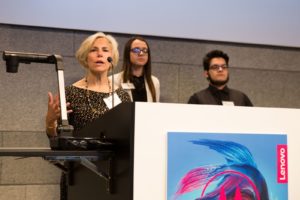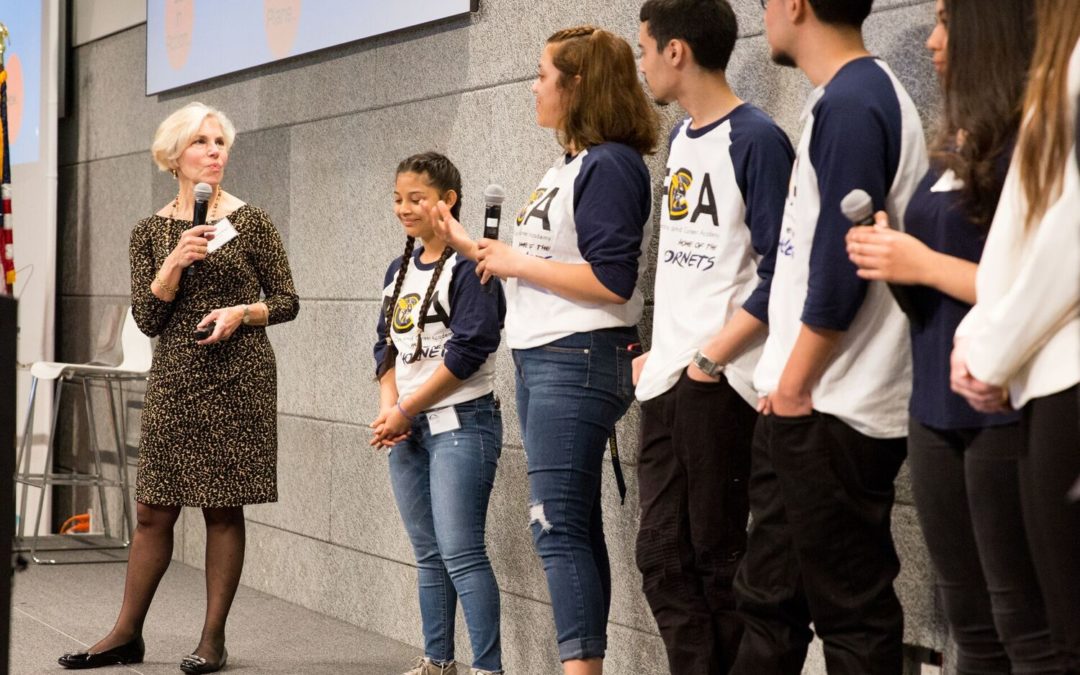BY ISTC Board Chair Shelley Stern Grach, Director, Civic Engagement for Microsoft Chicago
For the past five years, Microsoft has participated in ISTI’s STEM Challenge program to authentically engage with Chicago Public School students by presenting a technology challenge that allows students to develop their own innovations under the guidance of Microsoft mentors. Microsoft deepened its partnerships with CPS Early College STEM Schools Lake View High School and Corliss High School, as well as Foreman College and Career Academy on a challenge involving artificial intelligence (AI). One team from each school presented their findings at the STEM Student Showcase on April 26th at Motorola Mobility.
In this issue of Catalyst, Shelley Stern Grach, Director of Civic Engagement at Microsoft and ISTC/I Board Chair, reflects on the role of problem-based learning and mentorship in education.
When it comes to developing new innovations, understanding the human side of technology is just as important as understanding the technology itself. Innovators must look inside their own communities for direction and use technology as a tool to tackle identified needs and solve problems.
That’s why this year we asked students across three different Chicago high schools to experience AI firsthand by developing a conversational interface – or chatbot – that addressed a need or challenge in their community. Working in teams, students brainstormed and dove into their schools and neighborhoods to find the most pressing problems to solve.
One team of students designed and developed a multilingual chatbot to assist non-native speakers both at their school and the larger community. Another team’s bot – called Determined Efficient Accurate Friend (DEAF) – would translate American English into American Sign Language to bridge the gap for deaf students and parents when interacting with administrators, signing up for classes, or seeking one-on-one advice from teachers. Another team of students designed a bot to combat neighborhood violence that would also create a renewed sense of community safety. Their chatbot concept would connect users with local resources and aid.
“Giving students the agency to pursue a relevant problem to them or their community not only allows for authentic learning but puts students in the driver’s seat to utilize a technology solution that can make a difference in people’s lives. “
Larry, alongside a team of eight Microsoft mentors, guided student groups both in person and virtually through the ISTI’s Mentor Matching Engine, providing insight and feedback throughout the project development process. Giving students the agency to pursue a relevant problem to them or their community not only allows for authentic learning but puts students in the driver’s seat to utilize a technology solution that can make a difference in people’s lives.
Perhaps even more importantly, this kind of problem-based, experiential learning – which allows students to apply classroom learning to the real world and engage directly with industry professionals – helps to prepare students for lifelong learning to build essential workplace skills that are in high demand. Employers today cite critical thinking/problem solving, collaboration, communication, and creativity as the most sought-after skills when recruiting talent – all elements our partner high school students needed to utilize throughout the five-month process.
 Finally, there has been quite a bit of talk and supporting research indicating that young people ‘can’t be what they can’t see’. In fact, there is a profound disconnect between youth and careers in STEM fields, often driven by the lack of understanding and awareness of these jobs. Many students in classrooms – all too often females and students of color – don’t see themselves as “STEM students” or pursuing STEM fields like computer science or engineering.
Finally, there has been quite a bit of talk and supporting research indicating that young people ‘can’t be what they can’t see’. In fact, there is a profound disconnect between youth and careers in STEM fields, often driven by the lack of understanding and awareness of these jobs. Many students in classrooms – all too often females and students of color – don’t see themselves as “STEM students” or pursuing STEM fields like computer science or engineering.
Through engaging directly with STEM professionals and unpacking a real-world problem, new worlds can open up for students, generating not only new lines of site to jobs they never knew existed, but with greater confidence that they can get there.
Follow our journey with ISTI’s STEM Challenge across the years here.
WATCH:
WHAT WE’RE READING:
- Con un interesante proyecto, estudiantes de Chicago están listos para participar en el ‘Reto STEM’ [Univision Chicago]
- Meet 20 professionals shaking up Chicago business [Crain’s Business Chicago]
- Microsoft launches $25M program to use AI for disabilities [NBC Chicago]
- In quest for tech leadership positions, Chicago women band together to challenge ‘bro fest’ [Crain’s Business Chicago]
- Debunking 3 of the biggest myths about Midwest tech [VentureBeat]
- Education innovations are taking root around the world. What do they have in common? [Brookings]
- Illinois venture funding off to a hot start in Q1 [Chicago Inno]
- Will Congress ever solve the long wait for green cards? [Forbes]
- Get a look at the kind of tunnel Elon Musk wants to build in Chicago [Crain’s Business Chicago]
- Here, this year’s Fast 50 companies [Crain’s Business Chicago]
- 2018 Fortune 500 [Fortune]
- Amazon is selling facial recognition to law enforcement – for a fistful of dollars [Chicago Tribune]
- We need to change, Chicago startup funders say [Crain’s Business Chicago]
- Coinbase is reportedly opening an office in Chicago [Chicago Inno]

